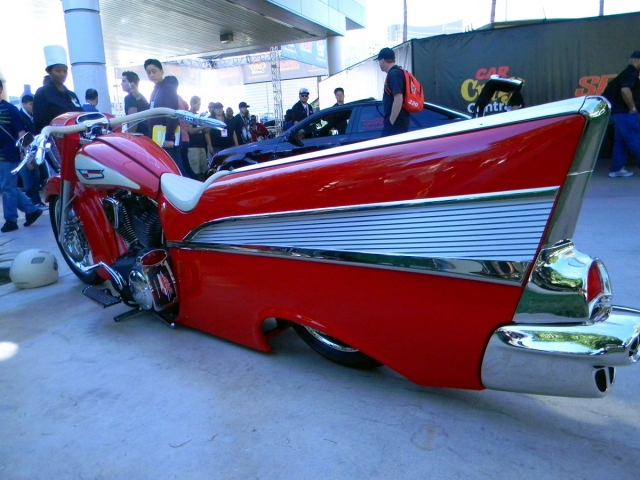
There are certainly different tastes when it comes to choosing the best of the best rides in the automotive industry. Some people prefer hot rods while others prefer modern muscle cars, etc. But the fact of the matter is, no matter what your individual taste may be, there is always something to be seen at the annual SEMA Show.
Last week, we were out in Las Vegas covering the event with a large number of staff members on the floor, each with their own individual tastes in cars and trucks. And while everyone’s Top 10 list of fabulous show vehicles is different, I’m excited to share my eclectic group of favorites (in no particular order) from the show floor.
 1971 Camaro- Owned by Dave and Karen Leisinger
1971 Camaro- Owned by Dave and Karen Leisinger
Built by Roger Burman of Lakeside Rods and Rides, this gorgeous ’71 F-body nicknamed “The Professor” after the engine builder is so custom that no body panel went untouched. This, as Burman told us, is more along the lines of his personal style of creating radical cars with an enormous amount of mods. And if the body modifications don’t do it for you, surely the engine powering this beast will.
 Set atop an Art Morrison chassis with Penske Racing shocks and a Watts-link rear, the Camaro makes use of a 500ci LSX motor built by Warren Johnson. This powerhouse, which is somewhat hidden under a custom engine cover, is capable of producing upwards of 800hp and 750 lb-ft of torque.
Set atop an Art Morrison chassis with Penske Racing shocks and a Watts-link rear, the Camaro makes use of a 500ci LSX motor built by Warren Johnson. This powerhouse, which is somewhat hidden under a custom engine cover, is capable of producing upwards of 800hp and 750 lb-ft of torque.
Of course, with this much power, you have to have a superior transmission backing the engine, which for the Camaro comes in the form of a Gearstar 4L80e automatic- the perfect combination for autocross racing, which the Leisingers plan to do with the car.
Other perfomance features you’ll find on this car are Baer brakes, a C6 Corvette front suspension system, and 18-inch front and 20-inch rear Boze wheels.
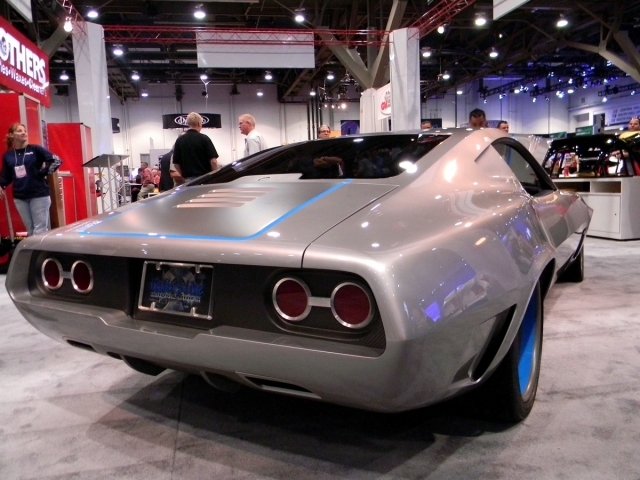
With rides like the famed “Scar” ’67 Camaro and “Crusher” ’70 Camaro in their stable of F-bodies, the Leisingers will certainly have plenty of beautiful cars to choose from come next autocross season!
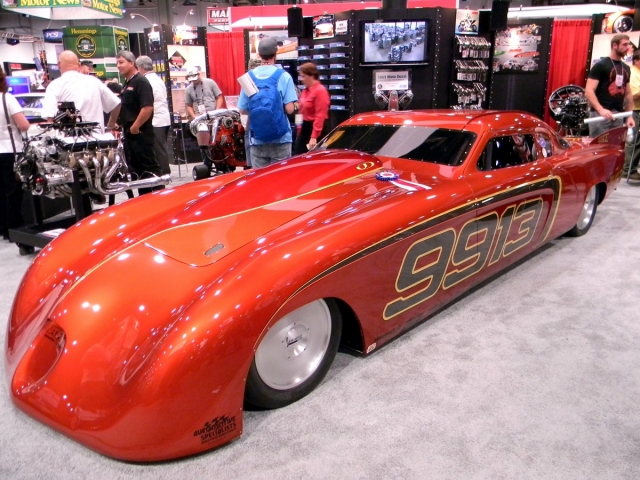
While traditional hot rodders can certainly respect a modified ’53 Studebaker, this particular car is one for the books.
 Rather than rodding it out, Alan Johnson of Johnson’s Hot Rod Shop turned this classic piece of Americana into a full-out Salt Flat race car.
Rather than rodding it out, Alan Johnson of Johnson’s Hot Rod Shop turned this classic piece of Americana into a full-out Salt Flat race car.
Equipped with a Chevy 369ci engine featuring SB2 heads, a Crane camshaft, Mahle pistons and a Holley carburetor and fuel pump, the Studebaker is capable of throwing down upwards of 900hp.
This will do the Gilliam’s good as they aim, with driver Shane Phillips, to be the first naturally-aspirated, 369ci-powered door car to hit 300mph on the Bonneville Salt Flats.
The powerful engine is backed by a Jerico 5-speed Air Shift transmission.
Already having been run on the salt, the Studebaker has proved capable of running 228mph in the Utah dessert. Not bad for a bona fide race car prepped like a show car!
 1968 Torino Talladega “GPT Special”- Owned by George Poteet
1968 Torino Talladega “GPT Special”- Owned by George Poteet
It’s not everyday that you see vintage NASCAR racing meet the street, but that’s exactly what this unique Talladega brings to the table.
 Built by Rad Rides by Troy, the melding of 60s and 70s style was the inspiration for this ride, which features front fenders shortened by 3 inches and quarters widened by 5 inches.
Built by Rad Rides by Troy, the melding of 60s and 70s style was the inspiration for this ride, which features front fenders shortened by 3 inches and quarters widened by 5 inches.
Giving the car a base fit for any NASCAR-inspired build is an Art Morrison chassis featuring a C5 Corvette front suspension system, Eaton Posi-traction rear and rack-and-pinion steering.
Powering the unique beast is a Boss 530 engine, complete with fuel injection and opened up with a Flowmaster exhaust. The result is 700hp and a car built for undeniable performance on the road.
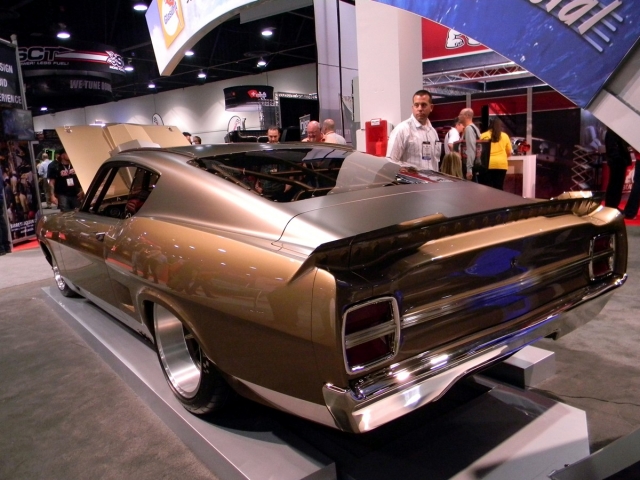
A truly spectacular car both inside and out, this was certainly a car not to be missed at this year’s SEMA Show.
When it comes to superior builds, Kindig It Design is at the top of the game. This year, owner and president of Kindig It, Dave Kindig, brought four cars to the SEMA Show, one of which was this incredible 1965 GTO.
 Built from a ’65 LeMans platform, the GTO features an Art Morrison chassis, electric power brakes, E-Stopp electric parking brake, Billet Specialties Fury wheels and red-line Michelin Pilot Sport tires. Powering the car is a 480hp LS3 engine tucked inside a highly custom engine bay, which is backed by a GM Performance 4L65e transmission. All the wiring on the car is compliments of AM Auto Wire.
Built from a ’65 LeMans platform, the GTO features an Art Morrison chassis, electric power brakes, E-Stopp electric parking brake, Billet Specialties Fury wheels and red-line Michelin Pilot Sport tires. Powering the car is a 480hp LS3 engine tucked inside a highly custom engine bay, which is backed by a GM Performance 4L65e transmission. All the wiring on the car is compliments of AM Auto Wire.
Adding to the performance and appeal of the GTO is a custom exhaust with Flowmaster Hushpower mufflers and electric cutout zoomies.
Giving the car its unique look is the smooth body panels, narrowed and split bumpers and patented Kindig-It smooth door handles. Topping the pristine body of the GTO is custom PPG paint in Quarter Horse Brown.
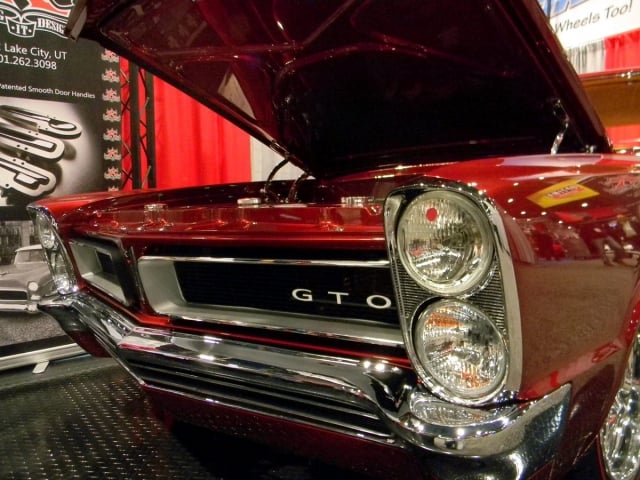
Built for performance, this bad boy is ready for the road as well as the show circuit.
 1972 Plymouth Duster- Featured On Season 8 of “Chop Cut Rebuild”
1972 Plymouth Duster- Featured On Season 8 of “Chop Cut Rebuild”
Nicknamed “Twisted,” this ’72 Duster stood out for more than one reason. Not only was it a TV show build project, it was also the only Duster and one of the only Plymouths we came across on the floor. But don’t let either of those things fool you into thinking we gave it an easy pass.
 Built on the “Chop Cut Rebuild” show with Dan Woods for Classic Industries, this classic Plymouth features a 426ci GEN III HEMI engine backed by a TCI 6-speed automatic transmission and cooled by a Bouchillon Performance Engineering radiator.
Built on the “Chop Cut Rebuild” show with Dan Woods for Classic Industries, this classic Plymouth features a 426ci GEN III HEMI engine backed by a TCI 6-speed automatic transmission and cooled by a Bouchillon Performance Engineering radiator.
Underneath the car, you’ll find a Reilly MotorSports suspension system, TTI headers and exhaust system with QTP exhaust cutouts, and Dr. Gas Exhaust Boom Tube exhaust tips.
Inside, the car is just as equipped, featuring a Mastershift in-dash shifter, Dakota Digital gauges, and a RetroSound audio system. The car also features OER restoration products and an ISIS Multiplex wiring system.
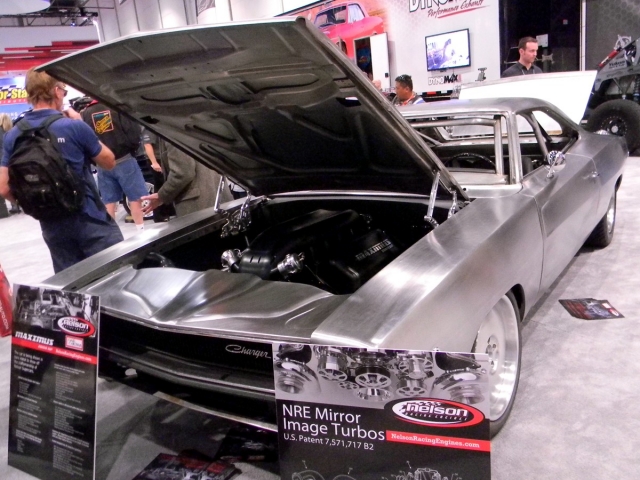 1968 Charger- Nelson Racing Engine’s Maximus
1968 Charger- Nelson Racing Engine’s Maximus
While SEMA is an amazing platform to show off new products, it also presents an opportunity for companies to show off what you can do with their products if you put your mind to it. This 1968 Charger known as Maximus is the perfect example.
 Equipped with a 9.4L HEMI engine built by Nelson Racing Engines, Maximus is capable of producing a killer 2000hp with the help of twin mirror-image turbochargers. Also helping give the engine its incredible power rating are an all-alloy construction, a dual fuel, electronic injection system- which gives the driver control over the horsepower (from 600hp to 2000hp) and allows for switches between pump and racing fuel, and custom NRE headers and exhaust fashioned out of 321 stainless steel, which was fully purged and Tig welded.
Equipped with a 9.4L HEMI engine built by Nelson Racing Engines, Maximus is capable of producing a killer 2000hp with the help of twin mirror-image turbochargers. Also helping give the engine its incredible power rating are an all-alloy construction, a dual fuel, electronic injection system- which gives the driver control over the horsepower (from 600hp to 2000hp) and allows for switches between pump and racing fuel, and custom NRE headers and exhaust fashioned out of 321 stainless steel, which was fully purged and Tig welded.
Giving Maximus the rigidity that it needs to handle 2000hp is a chassis that is 400 percent stiffer than the original, featuring a 1 ¾-inch chromoly tube roll cage. With this chassis, Maximus is certified to run zero to 160mph in 8 seconds at NHRA sanctioned events.
In its current form, the Maximus Charger can exceed 200mph, go from zero to 60mph in 2 seconds and run a quarter in 8 seconds.
 With numbers like that, stopping power is incredibly important which is provided by 14-inch rotors and 6-piston calipers. Of course, numbers like those are made possible particularly because of pavement griping power, which Maximus gets from its NRE triangulated 4 link, fully adjustable coilovers on all four corners, NRE Cad designed rear frame rails, splined adjustable sway bars, and extra tall forged dropped spindles all put together in a true 2013 race technology fashion.
With numbers like that, stopping power is incredibly important which is provided by 14-inch rotors and 6-piston calipers. Of course, numbers like those are made possible particularly because of pavement griping power, which Maximus gets from its NRE triangulated 4 link, fully adjustable coilovers on all four corners, NRE Cad designed rear frame rails, splined adjustable sway bars, and extra tall forged dropped spindles all put together in a true 2013 race technology fashion.
Aside from the car’s performance, it’s an amazing piece just to look at. Giving the car its unique look is 1500 hours worth of metal work, including widening the tail and bumper, stretched wheel arcs, hand-formed wheel tubs, widened rockers, widened rear door frames, a custom lower rear valance and tail moldings that were grafted into the rear quarters.
 Shown in bare metal to showcase the true craftsmanship of Nelson Supercars, Maximus will eventually be painted in a custom color and feature things like custom lighting and a hand-stitched German leather interior.
Shown in bare metal to showcase the true craftsmanship of Nelson Supercars, Maximus will eventually be painted in a custom color and feature things like custom lighting and a hand-stitched German leather interior.
 1954 GMC COE- Owned by Jon Stearns
1954 GMC COE- Owned by Jon Stearns
Built from the ground up in just 10 days by Welderup, this classic snubnose truck is fully fabricated inside and out and features many components from Stearn’s fruit farm, including neat oddities like old postcards that line the inside of the doors.
 Powered by a 6BT Cummins engine, built by Industrial Injection, with a single turbocharger, the GMC is good for about 450hp. Backing the powerhouse sticking out atop the bed is a dualie rearend, airbag suspension and 20-inch wheels.
Powered by a 6BT Cummins engine, built by Industrial Injection, with a single turbocharger, the GMC is good for about 450hp. Backing the powerhouse sticking out atop the bed is a dualie rearend, airbag suspension and 20-inch wheels.
Finished in its natural patina, the GMC will be featured next year on the Discovery Channel as part of the show about Welderup custom fabrication shop, which specializes in one-of-a-kind vehicles. Truly a one-of-a-kind creation, we just couldn’t help but falling in love with this simple, yet complex 50s GMC.
 1970 Chevelle- Mother’s Propane Powered Chevy
1970 Chevelle- Mother’s Propane Powered Chevy
Innovative technology certainly has its place at the annual SEMA Show and in the Mothers Polishes and waxes booth, we ran across this 1970 Chevelle being fueled strictly by propane. But don’t let that fool you- this bad boy is still mighty potent!
 The propane-powered Chevelle was the idea of Mothers’ own Jim Halloway, who turned to Johnny Omundson of Obrothers Design to turn the concept into reality. Omundson took care of the engineering and chassis work while the electrical engineering was left to Chris “Sparky” Versteegh and the engine development left to Mothers Polish as well as Propane Edge Group (PEG).
The propane-powered Chevelle was the idea of Mothers’ own Jim Halloway, who turned to Johnny Omundson of Obrothers Design to turn the concept into reality. Omundson took care of the engineering and chassis work while the electrical engineering was left to Chris “Sparky” Versteegh and the engine development left to Mothers Polish as well as Propane Edge Group (PEG).
Powered by a GM LSX 454ci crate engine, the Chevelle functions just about the same as your regular pump-gas cars, the only difference is the (LPI) Liquid Propane Injection system that fuels the classic Chevy.
With custom billet valve covers and a front drive system from Wegner Motorsports, a compression ratio of 11.0:1, Holley Dominator ignition, a Mattson Triple Pass radiator and custom Magnaflow headers attached to a custom exhaust, the Chevelle is capable of producing 925hp at 5,900RPM and 955lb-ft of torque at 3,500RPM with 10 to 12 pounds of boost pushed through a Magnuson supercharger.

 Underneath the car, you’ll find billet upper and lower control arms, Hypercoil springs, Penske Racing 8300 shocks, a Speedway Engineering differential and a ACPT carbon fiber driveshaft. The car also features an integrated 10-point roll cage.
Underneath the car, you’ll find billet upper and lower control arms, Hypercoil springs, Penske Racing 8300 shocks, a Speedway Engineering differential and a ACPT carbon fiber driveshaft. The car also features an integrated 10-point roll cage.
Giving the car plenty of pavement-gripping power are one-off wheels wrapped in Pirelli P Zone rubber. Stopping power comes compliments of Baer 6-piston mono block brakes with Tilton master cylinders.
Adding insult to injury, the car also features a custom interior done by Griffin Interiors and featuring Cobra seats, Auto Meter Phantom Series gauges, Katzkin dash, and Billet Specialties brightwork. The exterior is just as custom with new JRD window glass, Artistic Plating chrome plating, and custom paint laid by Chris Guinn and Spade Bros.
 1969 Camaro- Tom Bailey’s Sick Seconds Camaro
1969 Camaro- Tom Bailey’s Sick Seconds Camaro
Power is wonderful, but if you can’t do anything with it, it’s pointless. Well, lucky for Tom Bailey, the owner of this fine Camaro, his car does more than just the usual with its performance upgrades.
 Dubbed the quickest and fastest street car in America (yes, Bailey does drive this car regularly), Sick Seconds reigned in the 2013 Drag Week Championship title.
Dubbed the quickest and fastest street car in America (yes, Bailey does drive this car regularly), Sick Seconds reigned in the 2013 Drag Week Championship title.
Not only was the car the first ever to lay down 6-second passes at every Drag Week stop, the car also drove the hundreds of miles between tracks before competing each day.
In order to make this happen, Bailey had his car equipped with a 615ci big block built by Steve Morris Engines (SME) with Brodix 14.5-degree heads, a custom SME camshaft, Holley EFI, and Precision 94mm turbochargers.
Backing the powerful street and track-proven engine is a Rossler 210 TH400 transmission fitted with a ProTorque converter, and a Gear Vendors overdrive. The car also makes use of 3.89 rearend gears, Wilwood brakes, Wilwood hubs and 35×22.5-inch Hoosier DOT rear tires.
Giving the car its unique color are coats of BASF paint.
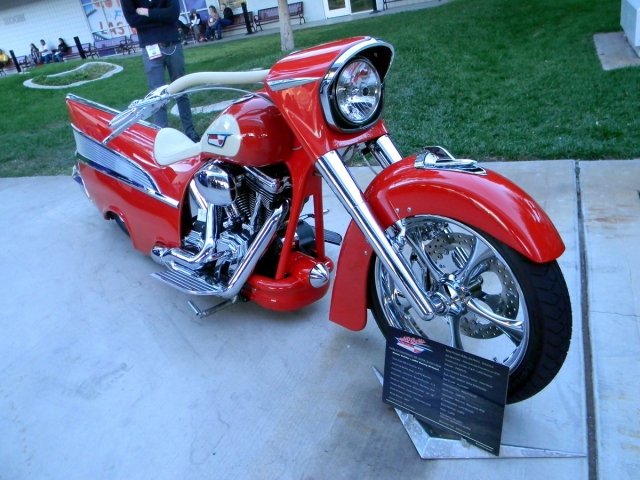 2008 Harley Davidson Dyna Street Bob
2008 Harley Davidson Dyna Street Bob
Last but certainly not least on my list is this ’08 Harley done up by France’s LUPO Racing as a tribute to the classic ’57 Chevy design. Although its not a killer car, its classic Tri-5 design cues couldn’t be ignored.
 Powered by a twin cam 96ci engine, the bike features EFI, a Vance & Hines exhaust, Hawg Halters front brakes, fork and triple trees, a hydraulic ride system from LUPO and 18-inch and 19-inch Renegade Monterey wheels.
Powered by a twin cam 96ci engine, the bike features EFI, a Vance & Hines exhaust, Hawg Halters front brakes, fork and triple trees, a hydraulic ride system from LUPO and 18-inch and 19-inch Renegade Monterey wheels.
But the performance components of this bike are not what caught our eye. Rather it was the custom body work emulating a classic Chevy finned rear fender, custom “hood” ornament, ’57 Chevy taillight and swooping body lines that caught our attention. In total, this build took over 3,000 hours.




























